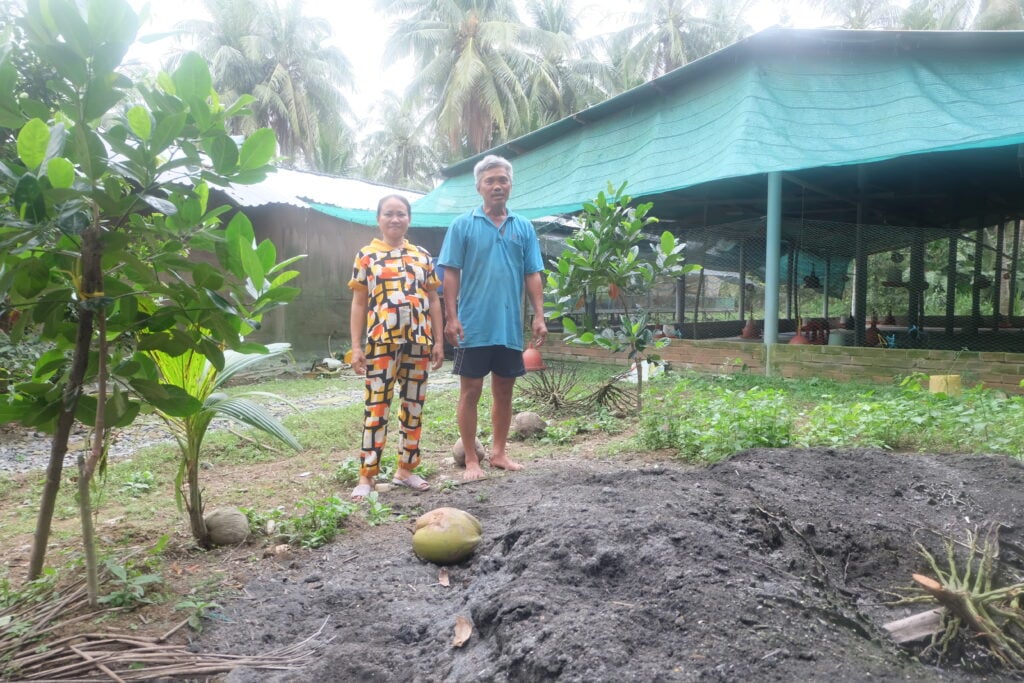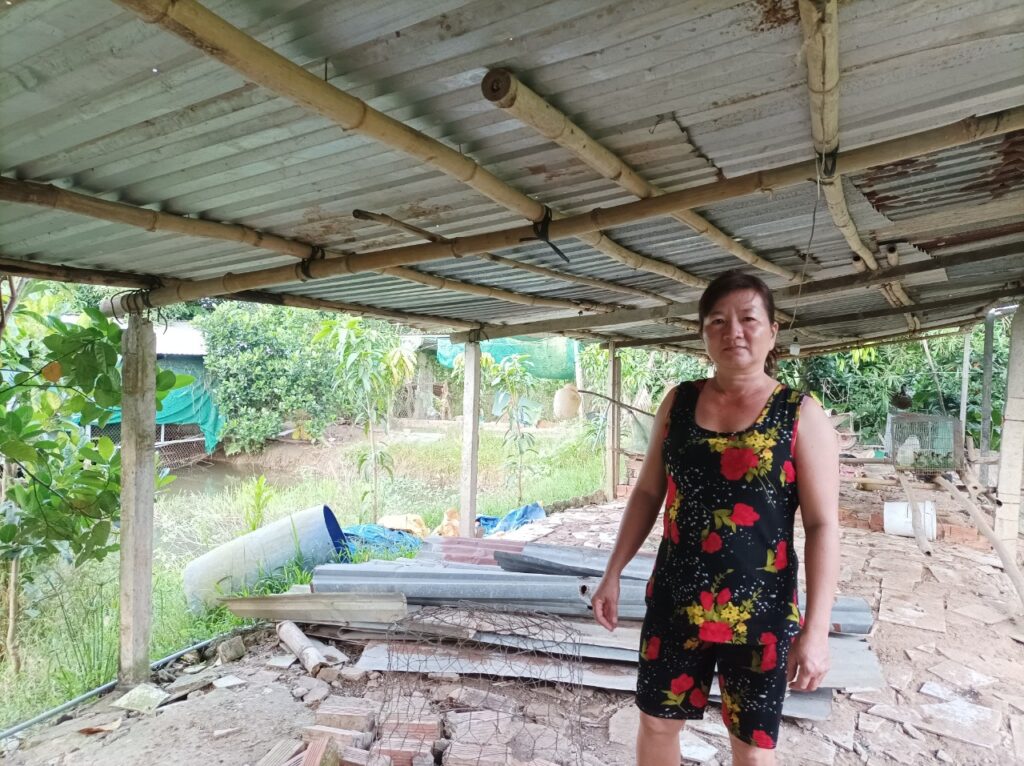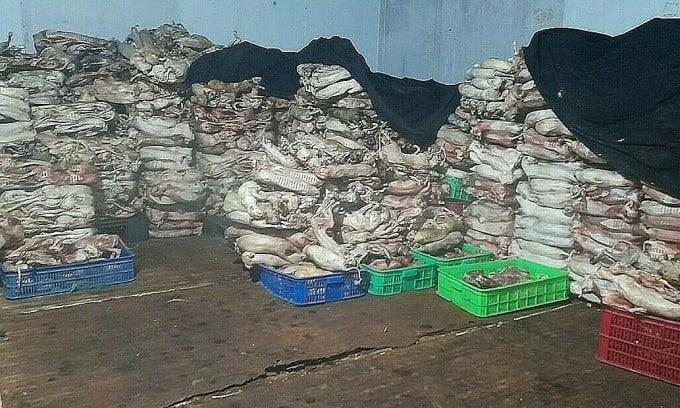CAN THO, VIETNAM – One evening in 2017, veterinary officials rushed to Nguyen Van Than’s farm in Cai Rang district, Can Tho city in Vietnam’s Mekong Delta. They put 4,000 chickens in burlap sacks and took them away in a van for burial.
Most of the chickens were healthy, but some had contracted avian influenza, so all had to be culled.
The culprit was H5N1, a highly contagious and deadly strain that first hit Vietnam 20 years ago. Than knew the risks, having attended workshops and meetings organized by local animal departments.
“They said it is a toxic disease and we have to prevent it,” said Than, who had vaccinated his entire flock, “but our chickens still got infected.”

Vietnam belongs to the minority of countries that mass vaccinate their poultry in an effort to eliminate avian influenza. But after nearly two decades of this policy, scientists are debating if vaccine research and development can keep up with the virus’ mutations.
Scientists are interested in influenza A because it evolves fast and spreads quickly. It is also the only type of influenza virus that had caused pandemics in the past, and many believed there will be more in the future.
Some of the deadliest pandemics in human history were caused by an influenza A virus that originated from poultry: the Spanish flu (1918-1919), the Asian flu (1957-1958) and the Hong Kong flu (1968).
The case for mass vaccinations
It was the fear of a spillover to humans that prompted Vietnam to start mass vaccinations of poultry in 2005. By then, the outbreak had ravaged the country’s poultry stocks for almost three years.
Frontline veterinary officials recalled the chaos. In the Mekong Delta’s largest city Can Tho, the Animal Health Sub-Department had to mobilize security guards to help stamp out the outbreak. Farmers abandoned their sick flocks en masse, forcing government staff to clean up everything.
In Tien Giang province, known as Vietnam’s poultry capital, all chickens and ducks within a 3-kilometer radius of an outbreak were culled. After two years, the poultry numbers nationwide decreased by nearly 15%.
The disease started spreading to humans, too. Dozens of people were infected in a span of three years, with a mortality rate of about 50%.
However, since the mass vaccination policy started in 2005, the number of humans infected with avian influenza has fallen significantly – only a handful in each of the years that followed. The Vietnamese government’s National Avian Influenza Prevention Plan for 2019-2025 aims to have at least 80% of the poultry in the country vaccinated.
The Tien Giang provincial government, for example, covers all vaccination fees for waterfowl. They believe that thanks to this policy, the number of avian influenza outbreaks was only a handful in the past three years. Most of the outbreaks were among chickens that had either not been vaccinated or had been given the wrong vaccine.
After the first epidemic in 2003, “if it has not been for the vaccine, no one would have dared to start raising chickens again,” said Nguyen Cong Thinh, the vice-director of the Center of Agriculture in Cho Gao district, Tien Giang.
He added that 80% of poultry in that district were vaccinated and they had no outbreaks since 2005, until one happened at a farm where the chickens were unvaccinated in October 2022.
The owner of that farm was Nguyen Ngoc Lam, from Hoa Dinh commune. A total of 2,600 of his chickens were burned in his garden.
Ngoc Lam had been farming chickens since 2007 and this was the first time his poultry became infected with avian influenza. He claimed he was unlucky because his flock was only 13-day-olds, too young to be vaccinated: “If they were vaccinated, they would be perfectly healthy,” Ngoc Lam said.

However, his conclusion is questionable. There has been no evidence in Vietnam to suggest that the vaccine in use matches the virus now circulating. Vietnam does not have sufficient capacity to evaluate an influenza vaccine’s effectiveness fast enough.
Of those institutions that do, the process is too slow due to disrupted workflows between governmental veterinary organizations and the bureaucracy.
This is crucial, because an “influenza virus evolves even faster than Sars-CoV-2,” said Nguyen Thanh Lam, a veterinary epidemiologist at Can Tho University. This means that an influenza A vaccine could become obsolete after only a few months.
In 2017, Thanh Lam sent 44 blood samples of vaccinated poultry in Vietnam to a Japanese lab to examine the vaccine’s efficacy against the circulating viruses. It turned out the vaccine efficacy had reduced significantly against the viruses in 2017, compared with the viruses before 2016.
In 2011 and 2012, vaccine efficacy evaluation results by the government showed that the vaccine did not protect against viruses circulating at that time. Of the chickens taking part in the test, 100% of them died. There was no choice but to stop the mass vaccination program in most parts of the country.
The case against vaccinations
“People who support vaccination want to reduce the human cases of avian influenza immediately, while people against it are looking at the longer term,” said Ken Inui, the former Food and Agriculture Organization expert who has advised the Vietnamese government on controlling avian influenza for 20 years.
Those against vaccinations have their reasons: If the effectiveness of the vaccine is not high enough, the vaccine would only encourage the virus to evolve faster, and the epidemic continues.
“If you look at China, Vietnam and Egypt, three notable representatives for a mass vaccination policy, you would see the virus there changes a lot and new viruses emerge constantly,” Inui said. Many European countries, the US and Japan consider mass avian influenza vaccination policies taboo and refuse to import poultry that has been vaccinated.
Nearly 80% of 65 countries that have been affected by avian influenza did not implement mass vaccinations, according to research in 2012 by David Swayne, a former expert with the World Organization for Animal Health. Most of those countries have successfully eradicated the disease using a stamping out policy – the poultry was simply rapidly culled.
Countries that have been successful at eradicating avian influenza have advantages over Vietnam: biosecurity and the ability to eliminate all outbreaks.
“Most of the people in the south free-graze their birds,” said Nguyen Quoc Vinh, the deputy director of the Animal Health Sub-Department in Can Tho city. This puts them at high risk of catching the virus from other farms and wild birds. His veterinary officials often had to chase the chickens, at times resorting to climbing trees, to get them vaccinated.
That way of raising birds would never meet biosecurity requirements, which call for an environment where a pathogen can be meticulously controlled.
Breeding ground for outbreaks
On average, Vietnam records 50 outbreaks of avian influenza each year. However, “that number is only the tip of the iceberg,” said Thanh Lam, the epidemiologist. Farmers can be disincentivized from reporting an avian influenza infection to the government because that would mean all their chickens would be culled without any certainty of when they would be compensated.
Instead, some quickly sell the chickens cheaply.
The traders then ship the potentially sick chickens to markets in cities, where they are put in the same cages as other chickens and waterfowls. This is despite the fact that many cities have imposed bans on slaughtering and trading live poultry.
“In 2004, we identified the market as a source of viruses to infect humans and so we tried to change market practices,” said Inui. “When I go to the market now, I see the same thing going on as in 2004. Yeah, the facility is halfway better, but the practice is still the same.”
Thanh Lam’s own study that looked into live poultry sold at markets in several Vietnamese provinces showed that 20-30% of samples were positive with low pathogenic avian influenza, and about 5-10% of samples, mostly belonging to waterfowl, were positive with high pathogenic avian influenza.

Slow vaccine development
If mass vaccinations is Vietnam’s only choice, besides speeding up the vaccine evaluation procedure, there is another challenge that needs to be overcome: updating the vaccines as fast as possible.
All avian influenza vaccines in Vietnam are either from China or Navetco, a Vietnamese state-owned enterprise. The first generation of avian influenza vaccine, RE-1, was first introduced to the market in 2003 and the most recent updated version of this vaccine is RE-14.
Even though there is a virus exchange between Vietnam and China, viruses in the two countries are not the same. Vietnam mainly uses RE-6 and will import RE-7 and RE-8 in upcoming years. Navetco’s own vaccine was out in 2009, but they did not update it until 2020.
At the heart of an avian influenza vaccine is an inactivated virus. This virus is not one that is found in nature, but an artificial one created by a reverse genetic technique.
The scientists at the Institute of Biotechnology, Vietnam Academy of Science and Technology, managed to create an inactivated virus in 2016. They transferred this work to Navetco. But instead of using it to produce a vaccine, the company opted for the antigen given by the US Center for Disease Control and Prevention, which is based on the virus that circulated in 2010.
Interview requests sent to Navetco went unanswered.
If Vietnam is unable to produce and update its vaccines fast enough, it will never have a vaccine that matches the current viruses circulating within its borders.
Despite that, Than, whose vaccinated chickens still got sick in 2017, did not lose faith in vaccinations. Whenever he raised a new batch of chickens, he vaccinated them twice until he stopped farming chickens in 2019 because the business was not profitable.
This story was produced with support from the STOP Spillover 2022 project led by USAID. Its Vietnamese version was originally published by Tia Sang Magazine.





